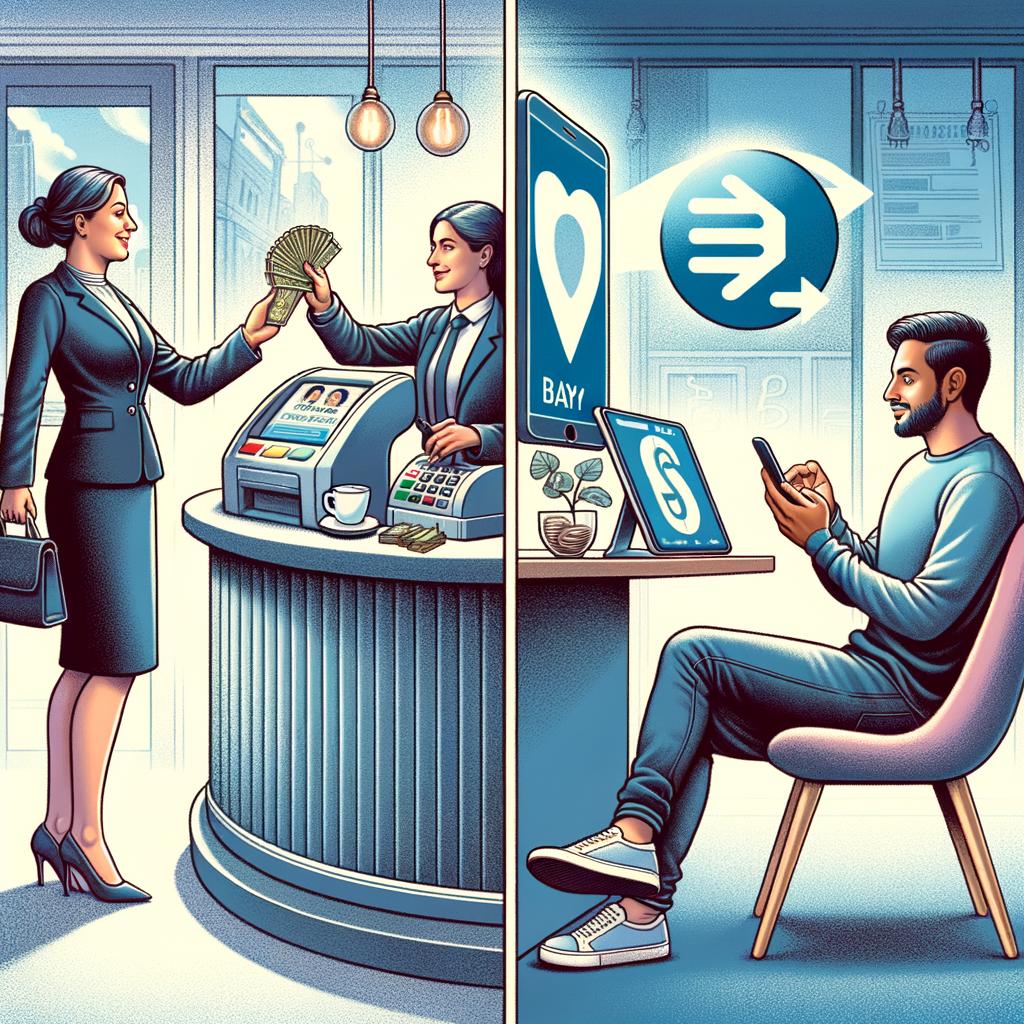Peer-to-Peer Payment Systems: The Growing Trend and Its Implications
Hey there, money movers and digital gurus! Imagine a world where splitting bills with friends is as swift as getting an adrenaline rush on a roller coaster. Well, welcome to the era of peer-to-peer payment systems! In this ever-evolving financial landscape, where smartphones are practically glued to our hands, we just can’t resist diving into the rising tide of convenient and instant money transfers. So, if you’re ready to explore the mesmerizing world of effortless transactions and the mind-boggling implications they bring along, buckle up! We’re about to embark on a thrilling journey into the wonderful realm of peer-to-peer payment systems.
Peer-to-Peer Payment Systems: Changing the Way We Pay
With the advent of peer-to-peer payment systems, the way we handle transactions has been revolutionized. Gone are the days when we had to carry cash or rely on traditional banking methods. These innovative systems have rapidly gained popularity, and it’s easy to see why. They offer convenience, speed, and a level of security that traditional payment methods simply can’t match.One of the key benefits of peer-to-peer payment systems is their ability to facilitate instantaneous transactions. Whether it’s splitting the bill at a restaurant or paying your share of rent, you can do it with just a few taps on your phone. No longer do you have to wait for checks to clear or make trips to the ATM. Additionally, these systems often integrate with popular messaging apps, making it even easier to send and receive money. Want to pay your friend back for those concert tickets? Simply send them a quick message and with a few taps, the money is in their account.
Another advantage of peer-to-peer payment systems is the enhanced security they offer. Unlike traditional payment methods where you have to provide your bank account or card details to the recipient, these systems use encrypted technology to keep your information safe. Additionally, many of these platforms offer buyer and seller protection, giving you peace of mind when making transactions online. Say goodbye to the worries of fraudulent charges or unauthorized access to your accounts – peer-to-peer payment systems have got you covered.
In conclusion, it’s clear that peer-to-peer payment systems are here to stay. They provide a convenient, fast, and secure way to handle transactions, making them the preferred choice for many individuals and businesses alike. So, next time you need to pay someone or collect money from a friend, why not give peer-to-peer payment systems a try? You’ll be amazed at how much easier and hassle-free it can be!
Pioneering the Future of Seamless Transactions
In the digital age, seamless transactions have become an essential part of our everyday lives. Peer-to-peer payment systems have emerged as a growing trend, revolutionizing the way we transfer money, split bills, and make payments. With the rise of popular platforms like Venmo and PayPal, it’s clear that this innovative technology is here to stay.
One of the key implications of this trend is the convenience it offers. Gone are the days of carrying cash or writing paper checks. With peer-to-peer payment systems, all you need is your smartphone and an internet connection to transfer funds instantly. Whether you’re splitting the cost of dinner with friends, paying rent to your landlord, or sending money to family members, these platforms make it quick and effortless.

The Rise of Peer-to-Peer Payment Systems: Benefits and Challenges
Peer-to-peer payment systems have experienced a remarkable surge in popularity in recent years, revolutionizing the way we handle monetary transactions. These innovative platforms enable individuals to transfer funds directly to one another without the need for traditional intermediaries such as banks. One of the key benefits is the convenience factor – these systems allow users to effortlessly split bills or instantly send money to friends or family. Additionally, peer-to-peer payment systems often offer lower fees compared to traditional banking services, making them an attractive option for cost-conscious individuals.Aside from their convenience and cost-effectiveness, peer-to-peer payment systems have also introduced new challenges to consider. Security is a major concern, as the transfer of funds between individuals may expose users to potential risks. To safeguard against such threats, it is crucial for these platforms to employ stringent security measures, including encryption protocols and two-factor authentication. Furthermore, customer support and dispute resolution processes are central to ensuring user satisfaction. Providers of these systems must strive to offer responsive and efficient support channels to address any issues that may arise.
While peer-to-peer payment systems offer a convenient and cost-effective alternative to traditional banking services, it is important for users to understand and weigh the benefits against the challenges. By staying informed and utilizing the security features provided, individuals can confidently embrace this growing trend and enjoy the ease of direct money transfers. So, whether you’re splitting the bill at a restaurant or sending money to a loved one, peer-to-peer payment systems are shaping the way we handle our finances, bringing a new level of convenience to our daily lives.
Navigating the Peer-to-Peer Payment Landscape: Tips for Secure and Hassle-Free Transactions
Peer-to-peer payment systems have become increasingly popular in recent years, revolutionizing the way we handle transactions. With the rise of platforms like Venmo, PayPal, and Cash App, more and more people are turning to convenient and hassle-free methods of transferring money to friends, family, and even businesses. However, with this growing trend comes the need for secure and reliable transactions. Here are some tips to help you navigate the peer-to-peer payment landscape and ensure your transactions are both safe and hassle-free.
Choose a reputable platform: When selecting a peer-to-peer payment system, opt for well-established platforms with strong security measures in place. Look for platforms that offer two-factor authentication, encryption, and protection against fraud. Popular options like Venmo and PayPal have a proven track record and offer a wide range of features to safeguard your transactions.
Verify the recipient: Before sending money, always double-check that you are sending it to the correct person. Many peer-to-peer payment platforms allow users to search for contacts by name, username, or phone number. Take the time to verify the recipient’s details to avoid any mistaken transfers. Additionally, you can use the platform’s “request money” feature to ensure you are sending funds to the intended recipient.
Set privacy settings: Protect your personal information by adjusting your privacy settings. Most peer-to-peer payment systems give you control over who can see your transactions and personal details. Consider limiting your visibility to friends only or adjusting privacy settings to your preferred level of comfort.
To Conclude
And there you have it, folks! Peer-to-peer payment systems, the cool new kids on the financial block. We’ve covered the basics, delved into their rapid rise in popularity, and even explored the implications they might have on our lives. Who would have thought that a simple app on our phones could revolutionize the way we handle money?
So, are these systems here to stay? Well, it sure seems like it! With more and more people embracing the convenience and security they offer, it’s safe to say that peer-to-peer payment systems have become an integral part of our modern lives.
But hold on a second, let’s not forget the bigger picture here. As we revel in the ease of splitting the dinner bill with a just a few taps, we might be overlooking the potential pitfalls. From concerns about privacy to the impact on traditional banking systems, there are still important questions to be answered. The future of peer-to-peer payment systems may hold more surprises than we can imagine.
One thing is for certain: this growing trend is anything but boring. With new features and innovations constantly being introduced, it’s an exciting time to be a part of the peer-to-peer revolution. So, whether you’re a tech-savvy millennial or a skeptical baby boomer, it’s time to hop on board and see where this wild ride takes us.
As we wrap up this article, we hope you’ve gained some insights into the world of peer-to-peer payment systems. Whether you’re a fan or a skeptic, they’re undeniably changing the way we handle money. So next time you reach for your wallet, think twice – your phone might just be the key to a whole new world of financial convenience.





